MICHELANGELO
THE FILMS:
MICHELANGELO: SELF-PORTRAIT (85-minutes)
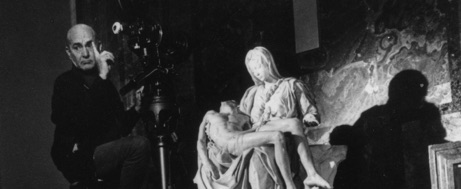
The film, which has been shown in a limited number of engagements in art theatres and museums, and swept the nation for two-years on PBS, has garnered high praise from critics. In the Los Angeles Times, Kevin Thomas wrote, "…as the camera caresses both marble and canvas alike, we hear Michelangelo's thoughts about his life and work. It evokes the very spirit of the man." The Philadelphia Inquirer called it a "…serious and sensuous portrait of Michelangelo." And in the Los Angeles Daily News, "…the timelessness and sheer beauty of its images make this film an experience not to miss." Bonnie Churchill wrote in The Christian Science Monitor, "…like a shaft of sunlight in a dark room, the commentary explores the sculptor's thoughts and emotions," and "…a very personal insight into Michelangelo's work and life."
In 1951, an earlier film on the artist titled The Titan: Story of Michelangelo, was produced by Snyder in black & white, and received rave notices before going on to win an Academy Award as Best Documentary Feature. One critic, the late James Agee, described it as "…a new and exciting way to see some of the greatest work ever done."
In making the decision to produce another film on Michelangelo, Snyder explains that there had been nearly three decades of scholarship on the artist, as well as discoveries of works by the Master. The latter include the wall drawings in the Sotteraneo, his early wooden crucifix, and his late Rondanini Pieta sculpture, all of which are documented beautifully in the new production.
In fact, Michelangelo, Self-Portrait opens with a close-up of the Rondanini Pieta, which the Master began carving when he was 89 years old. The audience hears Michelangelo's words: "I am carving another Pieta; God grant I may finish it. How different from my first in St. Peter's a lifetime ago when I was just 21. Beauty was my idol then. Faith alone must guide me now, as I face the day of judgment."
The film, which was written by a long-time collaborator and friend of Snyder, New York gallery president Michael Sonnabend, explores the artist's life and artistic evolution in his journey from a young Renaissance star, through his long spiritual crisis and finally to the saintly simplicity of his final years. Combining excerpts from Michelangelo's letters, poems and diaries with the rich visual images of his work photographed in full color. Some of the magnificent visuals include spectacular views of the Sistine Chapel, the Last Judgment (prior to the cleaning), the Pauline Chapel frescoes, and many other beautiful works by Michelangelo in both two and three dimensions. The grand visual images are accompanied by the austere strains of Renaissance composer Claudio Monteverdi.
Snyder and his cinematographer Umberto Galeassi had unprecedented access in six different countries to the works of art over the ten years that the film was in production. Snyder recalls, "Obtaining permission to film the St. Peter's Pieta was extremely difficult. You may recall that in 1972, a deranged visitor smashed the face of the Virgin. Since then, the Pieta has been protected with bullet-proof glass. No still or motion picture camera was permitted to go behind the partition. We negotiated with the Vatican officials for over a year before getting a special dispensation to work behind the glass which permitted us to photograph thoroughly and intimately - certainly the first and probably the last time such permission would be granted.
Robert Snyder video discussing the making of the film
THE TITAN: STORY OF MICHELANGELO (60-minutes)
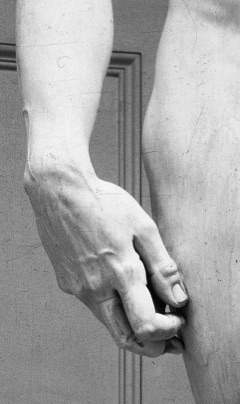
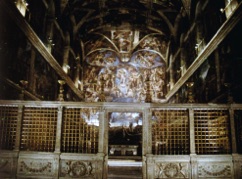
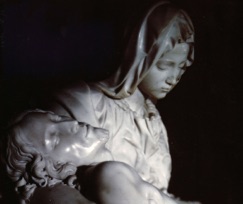
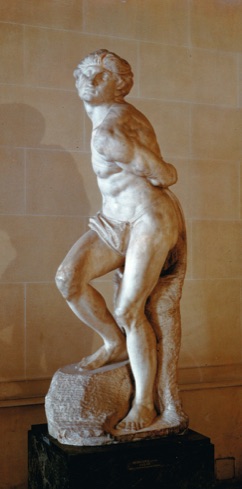

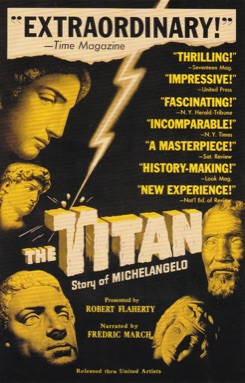

Robert Snyder's The Titan: Story of Michelangelo opened in 1951, and rightly earned that year's Academy Award for Best Documentary Feature. Adapted in part from Curt Oertel's Michelangelo: Life of a Titan, with a musical score by the noted German conductor Alois Melichar, Snyder's film was as powerful a tribute in its own time as was his Michelagniolo: Self Portrait of nearly four decades later. Again, we feel the swirl of violent events surrounding the artist's own struggles; the symbolic smashing of the great David sculpture becomes an allegory for its tragic times. The film bears the name, as sponsor, of the legendary documentarian Robert Flaherty; no greater tribute could be imagined... "The Titan is more than merely a relic of its times. Even in black and white, it set a new standard for bringing the essence of a sovereign artist to the screen. Robert Snyder's own passion for exploring the nature of artistic creativity is as evident here as in his later masterpiece. The critic James Agee described it as "a new and exciting way to see some of the greatest work ever done. It still is." - Alan Rich, Los Angeles Daily News
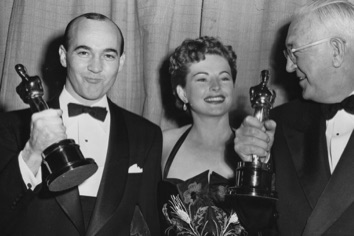
FILM PORTRAITS OF CREATIVE GIANTS
MASTERS & MASTERWORKS